A GILT COPPER ALLOY FIGURE OF MANJUSHRIMING DYNASTY, YONGLE SIX-CHARACTER MARK AND OF THE PERIOD (1403-24)
Himalayan Art Resources item no. 4814
17.6 cm (6 15/16 in.) highFootnotes明 永樂(1403-24年) 銅鎏金文殊菩薩像
「大明永樂年施」刻款
Provenance:
With Claude de Marteau, Brussels, by 1970s
One of the most outstanding pieces from Claude's collection is this handsome gilt bronze of Arapachana Manjushri, the bodhisattva of Perfected Wisdom, as the embodiment of the mantra, 'A Ra Pa Cha Na'. Appearing in Gandharan sculpture and early Mahayana texts around the first centuries of the Common Era, these five syllables are a mnemonic to fundamental precepts of Buddhism. 'A', the essence of all Dharma without beginning; 'Ra', the Dharma free of impurities; 'Pa', expounding on the ultimate truth; 'Cha', the Dharma detached from the cycle of death and rebirth; and 'Na', the nature of the Dharma devoid of name or form. When combined, they culminate into the highest form of all Buddhist knowledge. Consistent with iconographic conventions from this period, Manjushri raises in his right hand a sword, poised to slash away ignorance and illusion brought about by the phenomenal realm. In his left, he grasps the stem of a blue lotus supporting the Prajnaparamita sutra, a foundational Buddhist text of which Manjushri represents the meditative deity and male counterpart to Prajnaparamita, the goddess of Supreme Wisdom.
This beautifully-cast figure exemplifies the pinnacle of Chinese Buddhist art made in the imperial workshops of the Ming dynasty (1368-1644). Located near the feet of Manjushri is a Chinese reign mark which is written from left to right according to the reading orientation of the Tibetan language, Da Ming Yongle nian shi, or 'Bestowed in the Yongle era of the Great Ming'. Also known by his personal name Zhu Di (1360-1424) and posthumous title Chengzu, the Yongle emperor (r. 1403-24) is best known among the Ming rulers for his lavish patronage of art and Tibetan Buddhism. After overthrowing his nephew, the Jianwen emperor (r. 1398-1402), Yongle revived the patron-and-priest relationship first enacted by the Mongol rulers of the Yuan dynasty (1279-1368) in an effort to legitimize his rule. Instrumental to this goal was the creation of portable images in an innovative, imperial style that was either presented to visiting religious envoys or delivered to Tibetan monasteries as diplomatic gifts. Many of these examples survive in Tibet, testifying to the heightened period of exchange between Tibet and China during the first half of the 15th century (see a figure of Manjughosa in the Tsuglakang Temple, Lhasa, published in, von Schroeder, Buddhist Sculptures in Tibet, Vol. II, 2001, pp. 1268-9, no. 352C; Fig. A). Also based on the extant number of bronzes depicting the Lord of Wisdom in various forms, the Yongle emperor likely viewed himself to be the living incarnation of Manjushri in the aspect of an almighty ruler and spiritual successor to the Yuan (Watt and Leidy, Defining Yongle, 2005, p. 71).
As demonstrated by the present work, the best of imperial bronzes from the Yongle period are regarded for their refinement, exquisite gilding, and precision to detail. Incorporating elements from India, Tibet, and Nepal, this syncretic style was introduced by Newari artists employed in the Yuan court between the late 13th and 14th centuries. One noteworthy individual was Aniko (1244-1306), a young prodigy who entered the services of Khubilai Khan at the recommendation of the Sakya imperial preceptor, Phags-pa (1235-80) and was promoted as the Director of all Artisan classes. Although few works can unanimously be attributed to Aniko or his disciples, he is nevertheless credited with laying the foundation for Nepalese art to take root and flourish in the courts of the Yuan and early Ming. This development of Nepalese-inspired art is traceable in a gilt bronze Manjushri dated to 1305 of the Yuan dynasty, published in Watt, The World of Khubilai Khan, 2010, p. 111, fig. 145.
In its round yet well-proportioned face and plump upper torso, this gilt bronze ranks among the best of its type. Its Newari aesthetic is unmistakable not only in the voluptuous lotus petals and lavish jewelry, but in Manjushri's sensuous movement as he sways his hip to one side, causing his dhoti and the ends of the scarf draped over his shoulders to gently twist in response. The consecration plate is securely held in place by eight, evenly placed strike marks and was then applied with a layer of cinnabar lacquer in a manner consistent with Nepalese practices. The plate is also left un-gilded, revealing the figure's brass surface underneath. Past studies in the last decade confirm that important works such as the seated Buddha in the British Museum and thirty other figures in the Palace Museum, Beijing are all made from brass, denoting the alloy's widespread use within the larger corpus of early Ming works. (Wang and Priewe, "Scientific analysis of a Buddha attributed to the Yongle period of the Ming dynasty", in The British Museum Technical Research Bulletin, Vol. 7, 2013, pp. 61-8.)
Also noteworthy and rarely ever depicted is the space beneath his crossed legs where the loose folds of the dhoti would normally fall, accentuating the bronze with greater depth and volume. This particular feature is not only shared by the previously mentioned Manjughosa image measuring at 18 cm, but also by a handful of imperial bronzes whose intimate scaling and crown type suggest that they were made for respected Tibetan hierarchs as prized objects of personal devotion. Examples of similar quality can be seen in a Manjushri image at 18.7 cm sold at Christie's, New York, 21 March 2001, lot 86, and a figure of Vajrasattva at 18 cm from the Berti Aschmann Collection (Uhlig, On the Path to Enlightenment, 1995, p. 62, no. 22). Arguably the best of these comparisons is a Vajrasattva image at 18.4 cm formerly from the Speelman Collection, whose animated expression and rounded hairline closely relate to the following work, though varies in the thin, clinging lower garment (see Sotheby's, Hong Kong, 7 October 2006, lot 801).
A GILT COPPER ALLOY FIGURE OF MANJUSHRIMING DYNASTY, YONGLE SIX-CHARACTER MARK AND OF THE PERIOD (1403-24)
Himalayan Art Resources item no. 4814
17.6 cm (6 15/16 in.) highFootnotes明 永樂(1403-24年) 銅鎏金文殊菩薩像
「大明永樂年施」刻款
Provenance:
With Claude de Marteau, Brussels, by 1970s
One of the most outstanding pieces from Claude's collection is this handsome gilt bronze of Arapachana Manjushri, the bodhisattva of Perfected Wisdom, as the embodiment of the mantra, 'A Ra Pa Cha Na'. Appearing in Gandharan sculpture and early Mahayana texts around the first centuries of the Common Era, these five syllables are a mnemonic to fundamental precepts of Buddhism. 'A', the essence of all Dharma without beginning; 'Ra', the Dharma free of impurities; 'Pa', expounding on the ultimate truth; 'Cha', the Dharma detached from the cycle of death and rebirth; and 'Na', the nature of the Dharma devoid of name or form. When combined, they culminate into the highest form of all Buddhist knowledge. Consistent with iconographic conventions from this period, Manjushri raises in his right hand a sword, poised to slash away ignorance and illusion brought about by the phenomenal realm. In his left, he grasps the stem of a blue lotus supporting the Prajnaparamita sutra, a foundational Buddhist text of which Manjushri represents the meditative deity and male counterpart to Prajnaparamita, the goddess of Supreme Wisdom.
This beautifully-cast figure exemplifies the pinnacle of Chinese Buddhist art made in the imperial workshops of the Ming dynasty (1368-1644). Located near the feet of Manjushri is a Chinese reign mark which is written from left to right according to the reading orientation of the Tibetan language, Da Ming Yongle nian shi, or 'Bestowed in the Yongle era of the Great Ming'. Also known by his personal name Zhu Di (1360-1424) and posthumous title Chengzu, the Yongle emperor (r. 1403-24) is best known among the Ming rulers for his lavish patronage of art and Tibetan Buddhism. After overthrowing his nephew, the Jianwen emperor (r. 1398-1402), Yongle revived the patron-and-priest relationship first enacted by the Mongol rulers of the Yuan dynasty (1279-1368) in an effort to legitimize his rule. Instrumental to this goal was the creation of portable images in an innovative, imperial style that was either presented to visiting religious envoys or delivered to Tibetan monasteries as diplomatic gifts. Many of these examples survive in Tibet, testifying to the heightened period of exchange between Tibet and China during the first half of the 15th century (see a figure of Manjughosa in the Tsuglakang Temple, Lhasa, published in, von Schroeder, Buddhist Sculptures in Tibet, Vol. II, 2001, pp. 1268-9, no. 352C; Fig. A). Also based on the extant number of bronzes depicting the Lord of Wisdom in various forms, the Yongle emperor likely viewed himself to be the living incarnation of Manjushri in the aspect of an almighty ruler and spiritual successor to the Yuan (Watt and Leidy, Defining Yongle, 2005, p. 71).
As demonstrated by the present work, the best of imperial bronzes from the Yongle period are regarded for their refinement, exquisite gilding, and precision to detail. Incorporating elements from India, Tibet, and Nepal, this syncretic style was introduced by Newari artists employed in the Yuan court between the late 13th and 14th centuries. One noteworthy individual was Aniko (1244-1306), a young prodigy who entered the services of Khubilai Khan at the recommendation of the Sakya imperial preceptor, Phags-pa (1235-80) and was promoted as the Director of all Artisan classes. Although few works can unanimously be attributed to Aniko or his disciples, he is nevertheless credited with laying the foundation for Nepalese art to take root and flourish in the courts of the Yuan and early Ming. This development of Nepalese-inspired art is traceable in a gilt bronze Manjushri dated to 1305 of the Yuan dynasty, published in Watt, The World of Khubilai Khan, 2010, p. 111, fig. 145.
In its round yet well-proportioned face and plump upper torso, this gilt bronze ranks among the best of its type. Its Newari aesthetic is unmistakable not only in the voluptuous lotus petals and lavish jewelry, but in Manjushri's sensuous movement as he sways his hip to one side, causing his dhoti and the ends of the scarf draped over his shoulders to gently twist in response. The consecration plate is securely held in place by eight, evenly placed strike marks and was then applied with a layer of cinnabar lacquer in a manner consistent with Nepalese practices. The plate is also left un-gilded, revealing the figure's brass surface underneath. Past studies in the last decade confirm that important works such as the seated Buddha in the British Museum and thirty other figures in the Palace Museum, Beijing are all made from brass, denoting the alloy's widespread use within the larger corpus of early Ming works. (Wang and Priewe, "Scientific analysis of a Buddha attributed to the Yongle period of the Ming dynasty", in The British Museum Technical Research Bulletin, Vol. 7, 2013, pp. 61-8.)
Also noteworthy and rarely ever depicted is the space beneath his crossed legs where the loose folds of the dhoti would normally fall, accentuating the bronze with greater depth and volume. This particular feature is not only shared by the previously mentioned Manjughosa image measuring at 18 cm, but also by a handful of imperial bronzes whose intimate scaling and crown type suggest that they were made for respected Tibetan hierarchs as prized objects of personal devotion. Examples of similar quality can be seen in a Manjushri image at 18.7 cm sold at Christie's, New York, 21 March 2001, lot 86, and a figure of Vajrasattva at 18 cm from the Berti Aschmann Collection (Uhlig, On the Path to Enlightenment, 1995, p. 62, no. 22). Arguably the best of these comparisons is a Vajrasattva image at 18.4 cm formerly from the Speelman Collection, whose animated expression and rounded hairline closely relate to the following work, though varies in the thin, clinging lower garment (see Sotheby's, Hong Kong, 7 October 2006, lot 801).

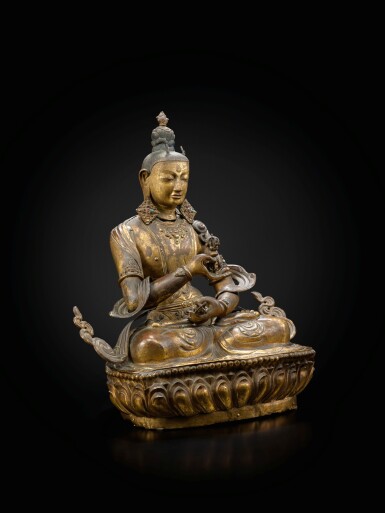
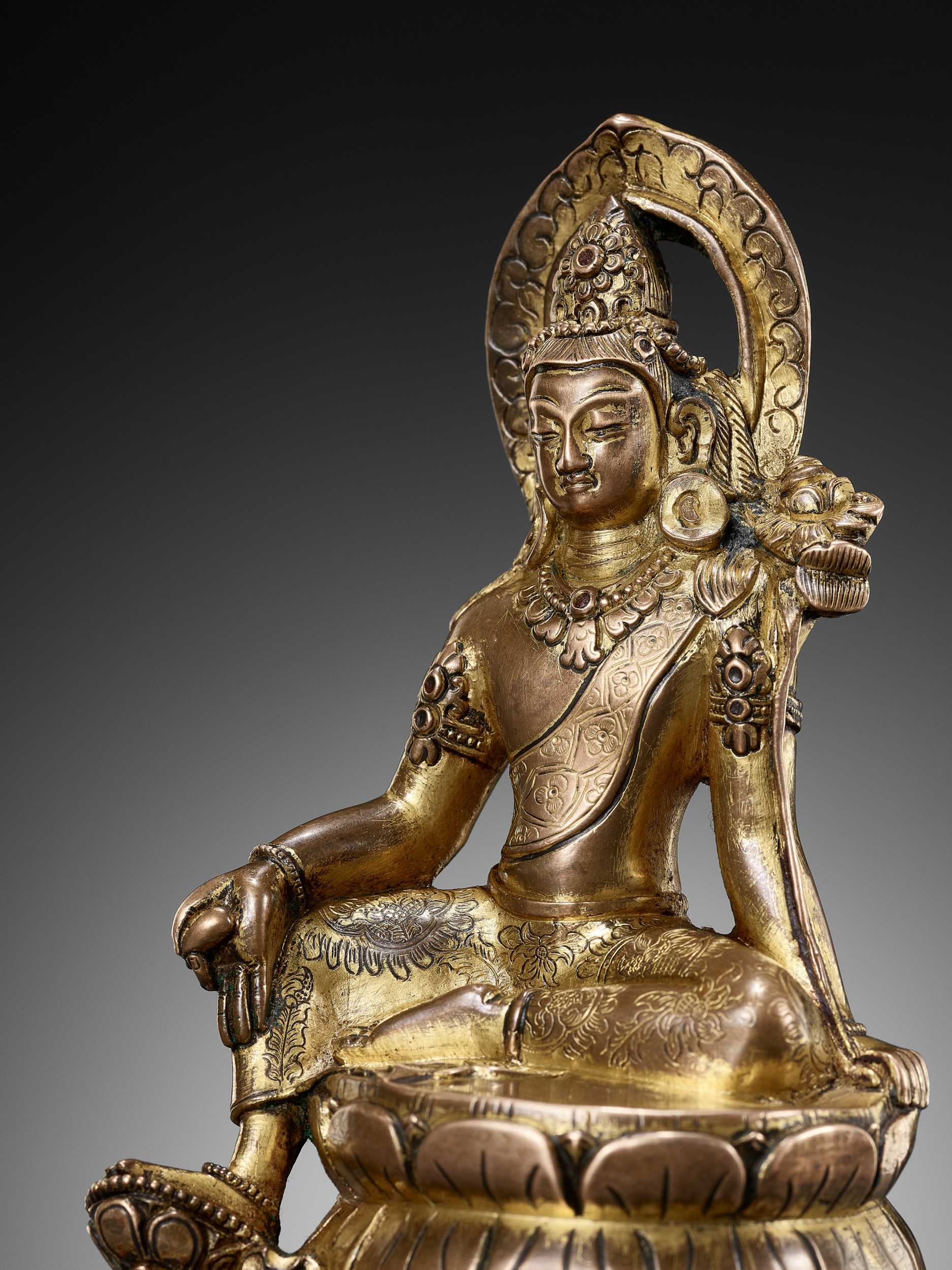
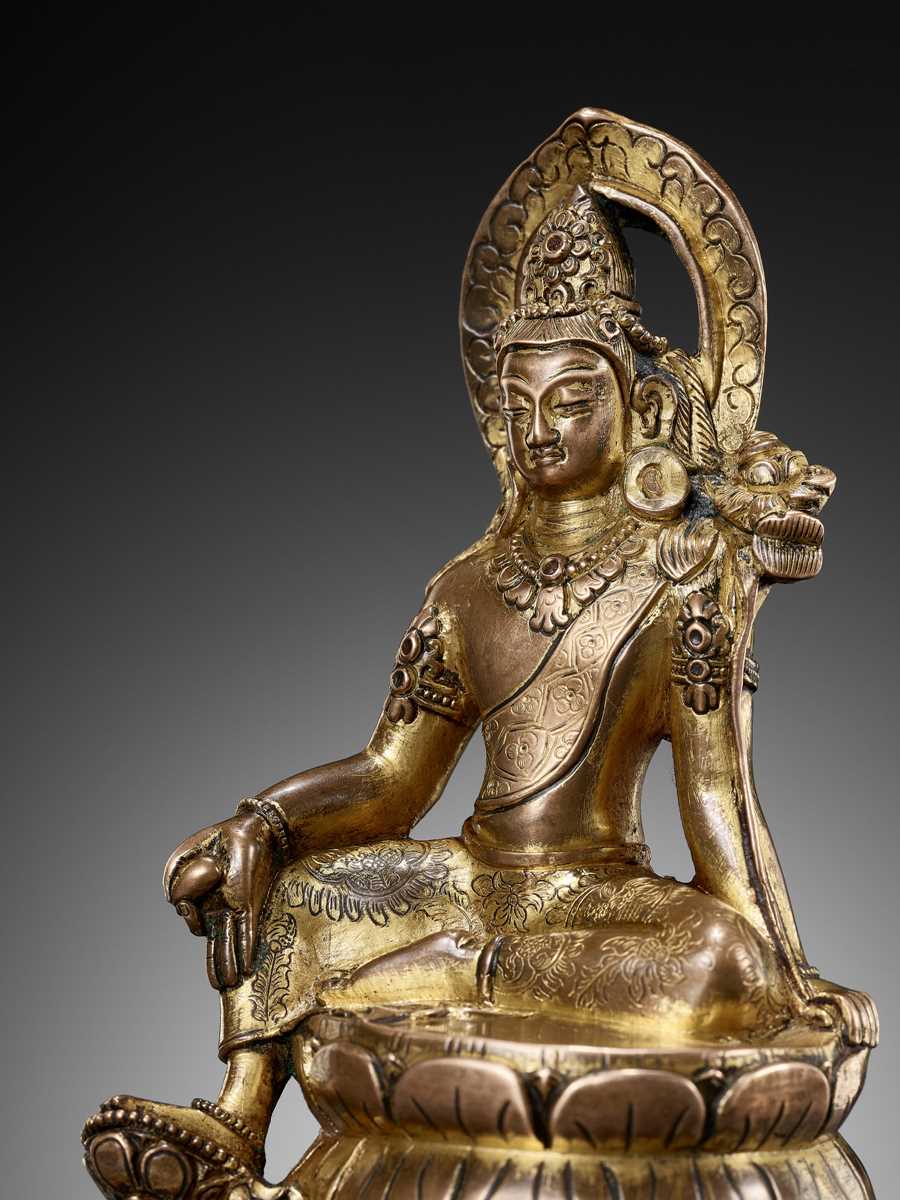







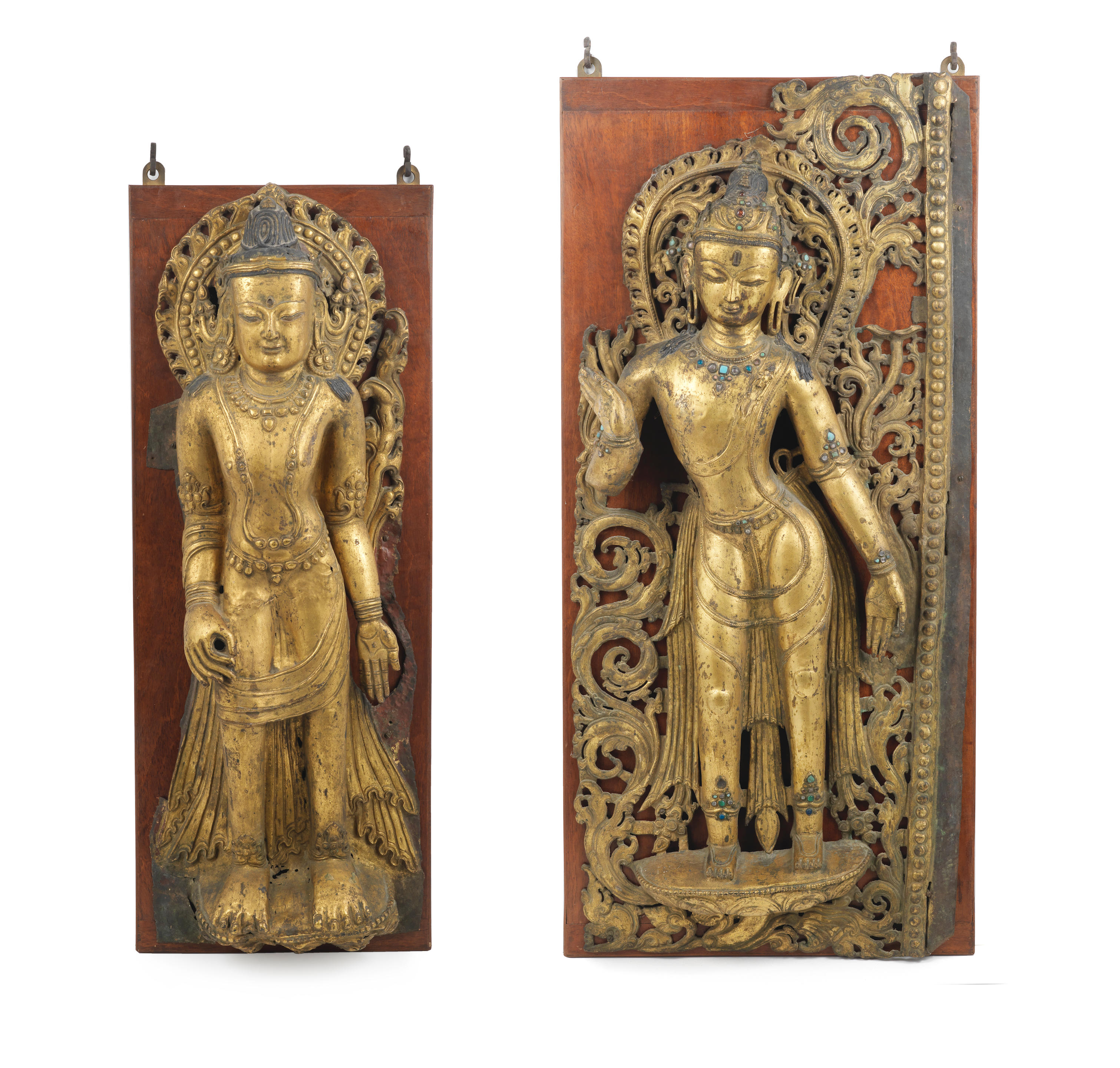
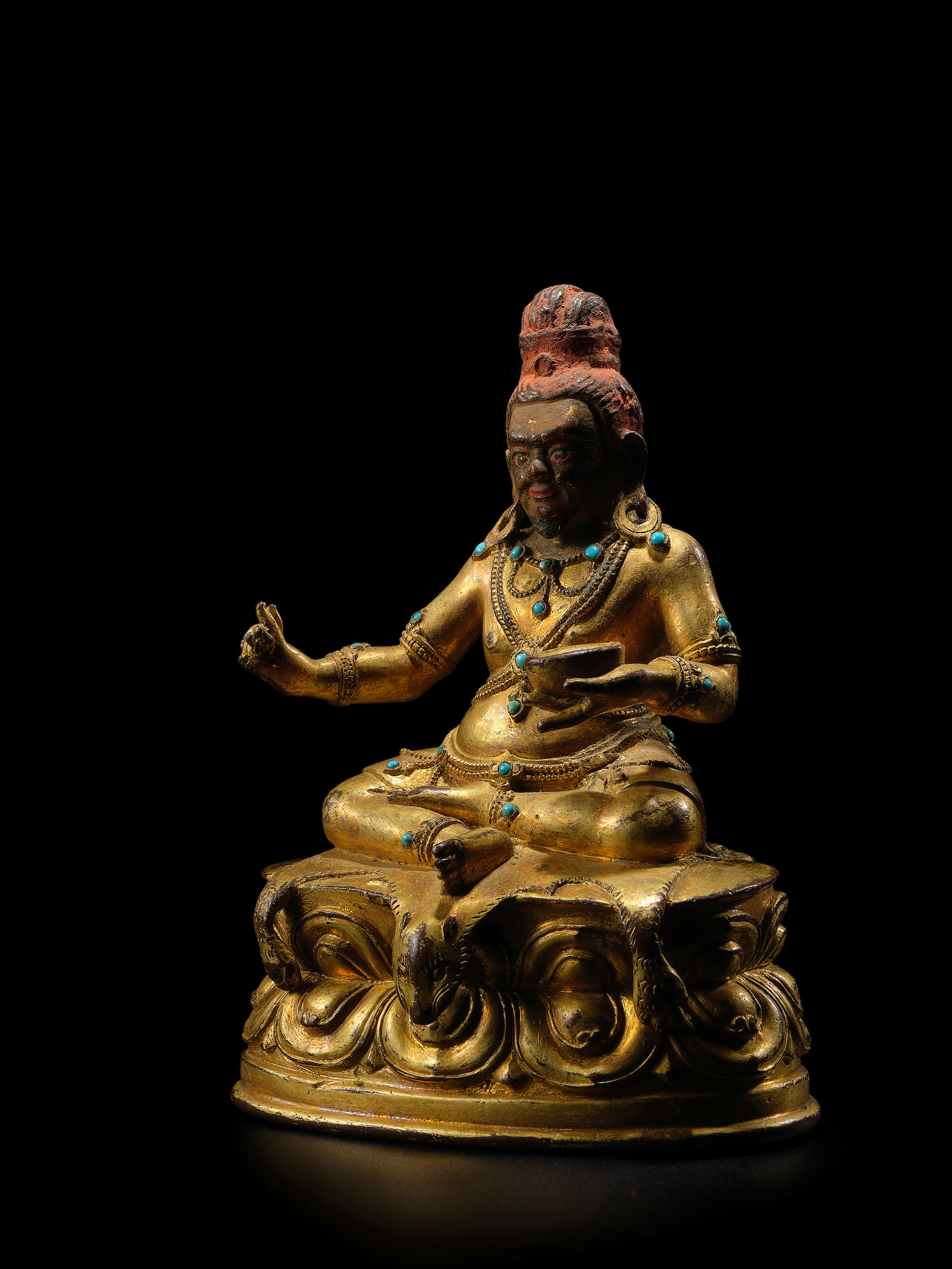

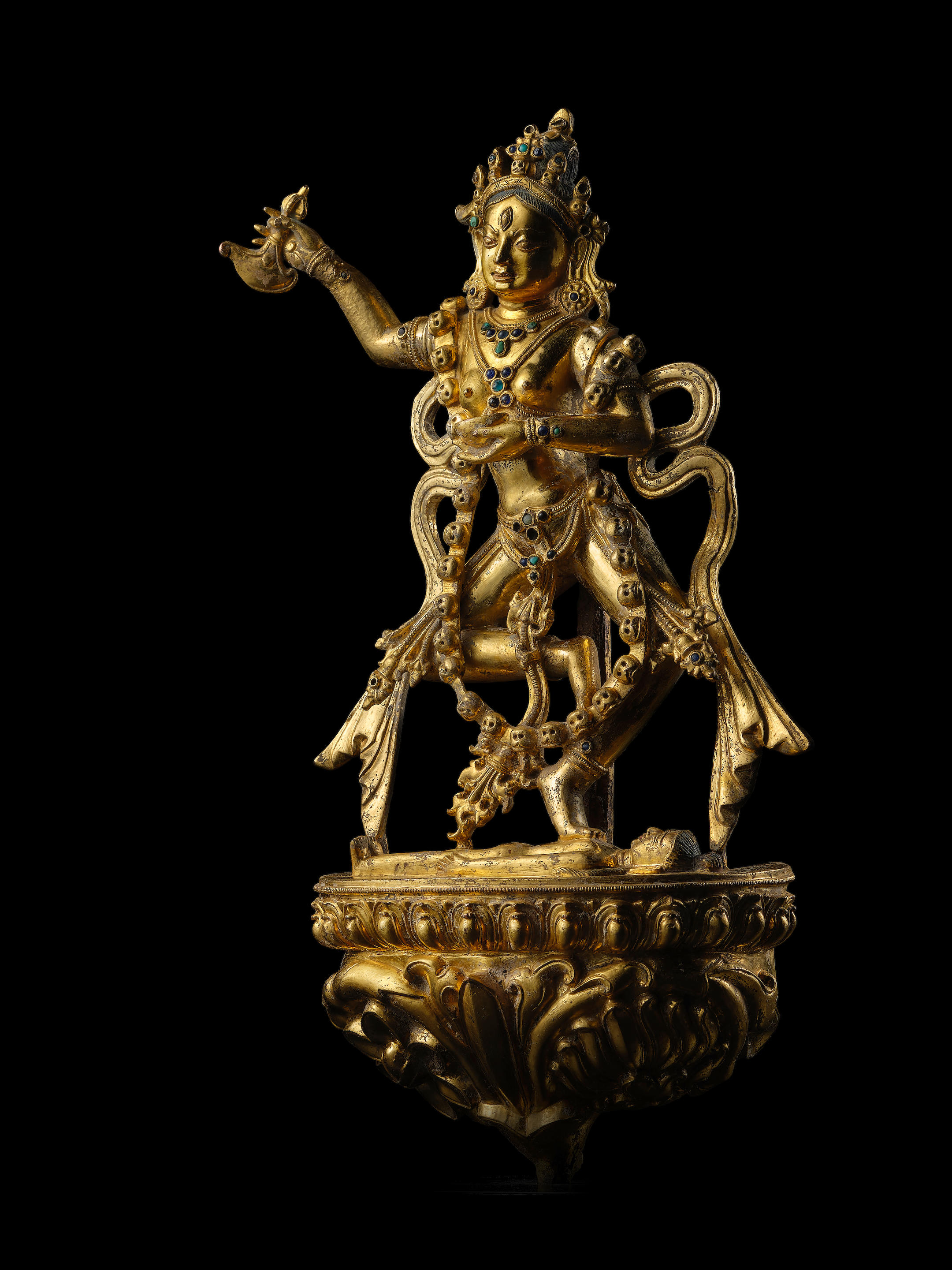
Try LotSearch and its premium features for 7 days - without any costs!
Be notified automatically about new items in upcoming auctions.
Create an alert